A collection of videos relating to the diagnosis and treatment of eye movement disorders. This collection includes many demonstrations of examination techniques.
Dan Gold, D.O., Associate Professor of Neurology, Ophthalmology, Neurosurgery, Otolaryngology - Head & Neck Surgery, Emergency Medicine, and Medicine, The Johns Hopkins School of Medicine.
A collection of videos relating to the diagnosis and treatment of eye movement disorders.
NOVEL: https://novel.utah.edu/
TO
| Title | Description | Type | ||
|---|---|---|---|---|
| 76 |
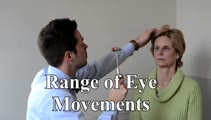 |
Range of Eye Movements and Evaluation for Nystagmus | 𝗢𝗿𝗶𝗴𝗶𝗻𝗮𝗹 𝗗𝗲𝘀𝗰𝗿𝗶𝗽𝘁𝗶𝗼𝗻: Range: Assesses for motility deficit due to an ocular motor palsy, particularly if a posterior fossa localization is being considered; Nystagmus: Spontaneous nystagmus may or may not be noted and gaze-evoked nystagmus is ... | Image/MovingImage |
| 77 |
 |
Saccades | Saccades: instruct the patient to make rapid movements of their eyes in each gaze direction, noting the speed, conjugacy, latency, and accuracy. First have the patient look between an eccentric target and the camera horizontally and vertically, making assessment of accuracy easier - e.g., overshooti... | Image/MovingImage |
| 78 |
 |
Evaluation of Auditory Function Using Rinne and Weber Tests | 𝗢𝗿𝗶𝗴𝗶𝗻𝗮𝗹 𝗗𝗲𝘀𝗰𝗿𝗶𝗽𝘁𝗶𝗼𝗻: The Rinne test is an assessment of auditory thresholds to air and bone conduction of sound. The Weber test is a comparison of bone conducted sound of either ear. Conductive hearing loss results in a loss of air conducte... | Image/MovingImage |
| 79 |
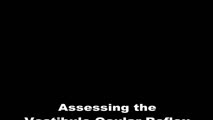 |
Dynamic Visual Acuity | 𝗢𝗿𝗶𝗴𝗶𝗻𝗮𝗹 𝗗𝗲𝘀𝗰𝗿𝗶𝗽𝘁𝗶𝗼𝗻: After assessing static binocular visual acuity, dynamic visual acuity (DVA) is determined by repeating the test during horizontal and vertical head shaking at 2-3 Hz. Dynamic visual acuity is most important to test when ... | Image/MovingImage |
| 80 |
 |
VOR Suppression | VOR suppression (VORS): instruct the patient to fix on the camera which they should hold in front of their eyes, while turning their torso slowly in the horizontal plane. The vertical plane can then be assessed by instructing the patient to flex and extend the neck under the same conditions. A demon... | Image/MovingImage |
| 81 |
 |
Smooth Pursuit | 𝗢𝗿𝗶𝗴𝗶𝗻𝗮𝗹 𝗗𝗲𝘀𝗰𝗿𝗶𝗽𝘁𝗶𝗼𝗻: A pursuit deficit in one direction suggests an ipsilesional localization, but beware of a superimposed spontaneous nystagmus; a pursuit deficit in all directions is commonly seen with cerebellar lesions. 𝗡𝗲𝘂𝗿�... | Image/MovingImage |
| 82 |
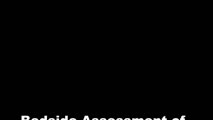 |
Provocative Maneuvers (Removal of Fixation, Vibration, Head-Shaking) to Accentuate Peripheral Vestibular Nystagmus) | 𝗢𝗿𝗶𝗴𝗶𝗻𝗮𝗹 𝗗𝗲𝘀𝗰𝗿𝗶𝗽𝘁𝗶𝗼𝗻: With an acute destructive process like vestibular neuritis that causes significant unilateral vestibular loss, spontaneous nystagmus is always present. However, over days to months, spontaneous nystagmus should resolve co... | Image/MovingImage |
| 83 |
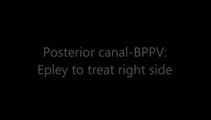 |
Posterior Canal - BPPV: Epley and Semont Maneuvers | 𝗢𝗿𝗶𝗴𝗶𝗻𝗮𝗹 𝗗𝗲𝘀𝗰𝗿𝗶𝗽𝘁𝗶𝗼𝗻: Epley/canalith repositioning maneuver (CRP) To treat right posterior canal (PC)-BPPV (each position maintained for at least 30 seconds or until nystagmus and/or vertigo cease): • First the patient is placed in the long-... | Image/MovingImage |
| 84 |
 |
Posterior Canal BPPV Pre- and Post-Epley Maneuver | 𝗢𝗿𝗶𝗴𝗶𝗻𝗮𝗹 𝗗𝗲𝘀𝗰𝗿𝗶𝗽𝘁𝗶𝗼𝗻: This is a patient with typical right posterior canal benign paroxysmal positional vertigo (BPPV), which was provoked by the Dix-Hallpike maneuver. When the patient was moved into the right Dix-Hallpike maneuver, after a b... | Image/MovingImage |
| 85 |
 |
Dix-Hallpike Maneuver in Posterior BPPV with Reversal of Nystagmus on Sitting Up | 𝗢𝗿𝗶𝗴𝗶𝗻𝗮𝗹 𝗗𝗲𝘀𝗰𝗿𝗶𝗽𝘁𝗶𝗼𝗻: This is a patient with typical posterior canal (PC) benign paroxysmal positional vertigo (BPPV), which is provoked by the Dix-Hallpike maneuver. When the patient is moved into the right Dix-Hallpike maneuver, after a brie... | Image/MovingImage |
| 86 |
 |
Vibration and Hyperventilation-induced Nystagmus from Vestibular Schwannoma | 𝗢𝗿𝗶𝗴𝗶𝗻𝗮𝗹 𝗗𝗲𝘀𝗰𝗿𝗶𝗽𝘁𝗶𝗼𝗻: This is a 50-yo-woman with imbalance, and with fixation removed on her examination (with Frenzel goggles), there was no spontaneous nystagmus. Using a handheld vibrator to vibrate the mastoids and vertex, there was a righ... | Image/MovingImage |
| 87 |
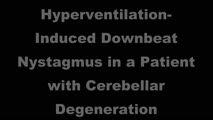 |
Hyperventilation-Induced Downbeat Nystagmus in a Cerebellar Disorder | 𝗢𝗿𝗶𝗴𝗶𝗻𝗮𝗹 𝗗𝗲𝘀𝗰𝗿𝗶𝗽𝘁𝗶𝗼𝗻: This is a 45-year-old woman with a chronic progressive cerebellopathy of unclear etiology (worsening over at least 10 years) characterized by gait and limb ataxia, gaze-evoked nystagmus, saccadic pursuit and vestibulo-ocu... | Image/MovingImage |
| 88 |
 |
Assessing for Hyperventilation-induced Nystagmus | 𝗢𝗿𝗶𝗴𝗶𝗻𝗮𝗹 𝗗𝗲𝘀𝗰𝗿𝗶𝗽𝘁𝗶𝗼𝗻: Hyperventilation induced nystagmus is tested by asking the patient to take quick deep breaths (~1/s) for 40-60 seconds. This decreases ICP and increases CSF pH. This can be helpful in diagnosing irritative conditions of ... | Image/MovingImage |
| 89 |
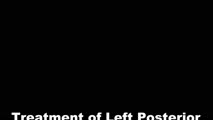 |
Posterior Canal BPPV Treated with Semont Maneuver | This is a patient with left posterior canal (PC) benign paroxysmal positional vertigo (BPPV), and upbeat-torsional (towards the left ear) nystagmus was provoked by left Dix-Hallpike maneuver and left side-lying maneuver. This video demonstrates treatment of her left PC BPPV with the Semont maneuver.... | Image/MovingImage |
| 90 |
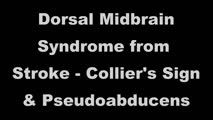 |
Dorsal Midbrain Syndrome from Stroke - Collier's Sign & Pseudoabducens | This is a 70-yo-man who suffered a right midline thalamic/rostral midbrain hemorrhagic stroke causing a pretectal (Parinaud's) syndrome. There was prominent eyelid retraction (Collier's sign), a left pseudo-abducens, and upgaze palsy with convergence retraction nystagmus. There was no light-near dis... | Image/MovingImage |
| 91 |
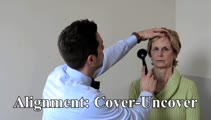 |
Ocular Alignment | 𝗢𝗿𝗶𝗴𝗶𝗻𝗮𝗹 𝗗𝗲𝘀𝗰𝗿𝗶𝗽𝘁𝗶𝗼𝗻: These tests allow for detection of eso-, exo- or hyperdeviations (phorias (one eye viewing) or tropias (both eyes viewing) that can be seen with ocular motor palsy, skew deviation, or with cerebellar disease (commonly eso... | Image/MovingImage |
| 92 |
 |
Enhanced Ptosis in Myasthenia Gravis | This is a 20-yo-woman who presented with generalized weakness, ptosis and ophthalmoplegia. She had severe ptosis OU at baseline, but when one eyelid was manually elevated, there was marked enhanced ptosis of the opposite eyelid. This was in accordance with Hering's law of equal innervation of the le... | Image/MovingImage |
| 93 |
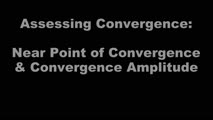 |
Evaluation of Convergence | 𝗢𝗿𝗶𝗴𝗶𝗻𝗮𝗹 𝗗𝗲𝘀𝗰𝗿𝗶𝗽𝘁𝗶𝗼𝗻: The assessment of convergence includes measuring alignment at near versus distance (see video, https://collections.lib.utah.edu/details?id=187677), near point of convergence and convergence amplitude. Near point of conve... | Image/MovingImage |
| 94 |
 |
Demonstration of HINTS Examination in a Normal Subject | In the acute vestibular syndrome - consisting of acute prolonged vertigo, spontaneous nystagmus, imbalance, nausea/vomiting, head motion intolerance which is typically due to vestibular neuritis or posterior fossa stroke - a 3 step test of ocular motor and vestibular function known as HINTS, has hig... | Image/MovingImage |
| 95 |
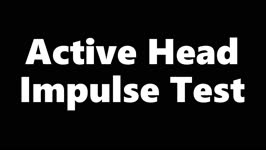 |
Active Head Impulse Test | Active head impulse test (HIT): instruct the patient to fix their eyes on the camera and turn their head 20o to the right/left, and then make a rapid movement toward the midline to align their head with the camera again, keeping their eyes fixed on the camera throughout. A simple instruction is to a... | Image/MovingImage |
| 96 |
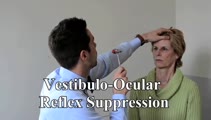 |
VOR (Suppression) | 𝗢𝗿𝗶𝗴𝗶𝗻𝗮𝗹 𝗗𝗲𝘀𝗰𝗿𝗶𝗽𝘁𝗶𝗼𝗻: Deficits in pursuit and vestibulo-ocular reflex (VOR)S usually go together, except when the VOR is absent or markedly diminished in which case there is no VOR to suppress, so that VORS seems better than pursuit. This is a... | Image/MovingImage |
| 97 |
 |
Measuring Divergence Amplitude | Divergence insufficiency should be suspected in patients with binocular horizontal diplopia at distance (but not near) who lack abduction deficits. There should be an esodeviation greater at distance, and in older patients with levator dehiscence (or previous ptosis surgery) and prominent superior s... | Image/MovingImage |
| 98 |
 |
Convergence | Convergence: instruct the patient to focus on their thumb held at arm's length, and slowly move their thumb towards their nose. This may bring out or cause reversal of vertical nystagmus (e.g., transition from upbeat to downbeat nystagmus in Wernicke's encephalopathy [see example of transition from ... | Image/MovingImage |
| 99 |
 |
Slow Horizontal, Vertical, Oblique Saccades and Gaze-evoked Nystagmus in Anti-AGNA-1 Encephalitis | This is a patient who presented subacutely with imbalance and dizziness. On examination, she had evidence of gaze evoked nystagmus, right internuclear ophthalmoplegia, as well as slow saccades horizontally and vertically. She was diagnosed with a rare antibody-mediated disorder, anti-AGNA-1 (antig... | Image/MovingImage |
| 100 |
 |
Neuro-Ophthalmic Features and Pseudo-MG Lid Signs in Miller Fisher Syndrome | 𝗢𝗿𝗶𝗴𝗶𝗻𝗮𝗹 𝗗𝗲𝘀𝗰𝗿𝗶𝗽𝘁𝗶𝗼𝗻: This is a 51-year-old woman who presented with imbalance, acute onset dizziness and diplopia that developed over three days following two weeks of upper respiratory infection and bacterial conjunctivitis. When she was ini... | Image/MovingImage |
